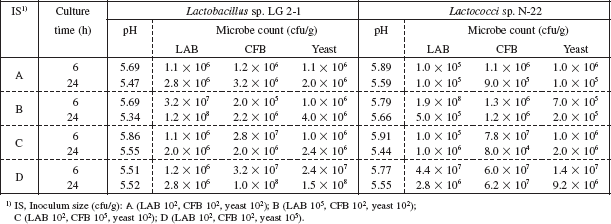Modification of the pouch method to evaluate the ability of lactic acid bacteria (LAB) strains for improving silage quality
Description
[Objectives]
In Thailand, most cows are fed with fresh pasture crops, grasses, and rice straw, and produce an average amount of raw milk at about 3,100 kg/head/lactation. However model farms and innovative farmer groups produce a significantly greater volume of raw milk, 4,200-4,500 kg/head/lactation, by feeding superior quality silage. Silage-making in Thailand is not a common technique, and improving the quality of silage is not easy. One major reason for this involves the complexity of bacteria effects during silage fermentation. It is well known that lactic acid bacteria (LAB) is essential for silage-making, and thus, a silage fermentation model was constructed to evaluate LAB specifically adapted to the tropical environments of Thailand by modifying the pouch method, a simple and easy system used to evaluate LAB in Japan.
[Results]
To modify the pouch method, microbial floras of silages prepared in Thailand were examined (Table 1). The LAB, aerobic bacteria, enterobacteria (coli form bacteria: CFB) and yeast were major microbes, and the counts of each microbes were different very much between grass silage and corn silage. For in grass silages, the counts of CFB and yeast were relatively abundant, but counts of LAB were low.
A silage fermentation model was constructed by modifying the pouch method in which napiergrass was used as silage material and yeast strain Saccharomyces serevisiae SG2-1Y and CFB strain Enterobacter sp. SG1-1T were used as typical silage microbes. Napiergrass was harvested after 30 days of cultivation, dried at 105°C, and then autoclaved. After inoculation with the yeast, and CFB and LAB strains, napiergrass (with moisture content adjusted to 75% and 1.5% of glucose added) was placed into a bag made from air-tight plastic film (oxygen permeability: 1 ml/m2/day), sealed by vacuum sealer and cultured at 45°C for 2 days.
The inoculation size greatly affected the growth of each silage microbe in the pouch. For example as shown in Table 2, when the inoculation size of LAB strain LG2-1 was 103 times higher than that of yeast and CFB, the LAB growth was accelerated while the CFB growth was repressed. However, LAB strain N-22 never repressed the growth of yeast and CFB in its early growth stage. Therefore, the mixture of LAB strain LG2-1 and N-22 with a high inoculation size causes the quick LAB growth. This in turn causes pH levels to drop quickly from the early stage.
The modified pouch method can evaluate a substantial quantity of LAB strains easily and quickly, helping researchers to screen practical-use LAB strains that can contribute to improving the quality of silage in tropical regions, including Thailand.
Figure, table
-
Table 1. Fermentation quality and microbial flora of silages prepared in Thailand.
-
Table 2. Effects of inoculum size on the growth of typical silage microorganisms in a pouch.
- Affiliation
-
Japan International Research Center for Agricultural Sciences Animal Production and Grassland Division
- Classification
-
Technical A
- Term of research
-
FY2002 (FY2000-2003)
- Responsible researcher
-
OHMOMO Sadahiro ( Animal Production and Grassland Division )
NITISINPRASERT Sunee ( Kasetsart University )
HIRANPRADIT Supanit ( Department of Agriculture Thailand )
- ほか
- Publication, etc.
-
Ohmomo, S., Nitisinprasert, S. and Hiranpradit, S. (2002): Silage-making and recent trend of dairy farming in Thailand. JARQ, 36(4), 227-234.
Silage-Making and Recent Trend of Dairy Farming in Thailand
Ohmomo, S., Nitisinprasert, S. and Hiranpradit, S. (2003): How to screen favorable lactic acid bacteria, from the case of bacteriocin producing strain and silage fermentation starter strain. Proceeding CD-ROM, The world of indigenous fermented foods for technology development and food safety. I-6. Kasetsart University, Bangkok, August 2003.
- Japanese PDF
-
2002_13_A3_ja.pdf955.34 KB
- English PDF
-
2002_13_A4_en.pdf48.75 KB


